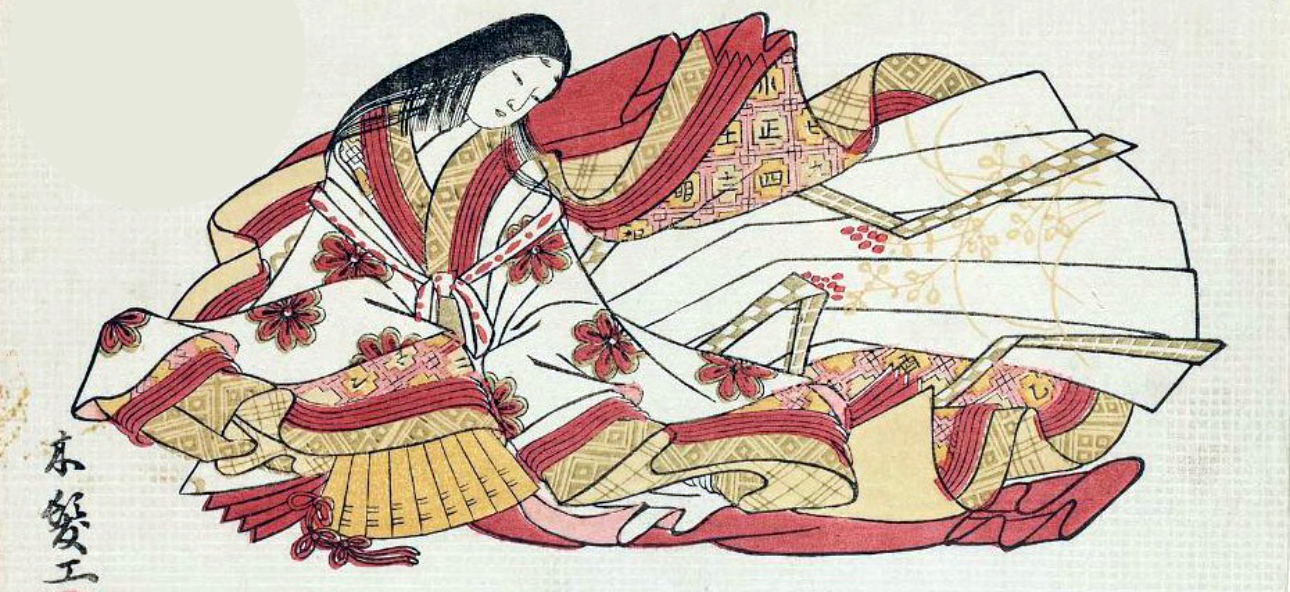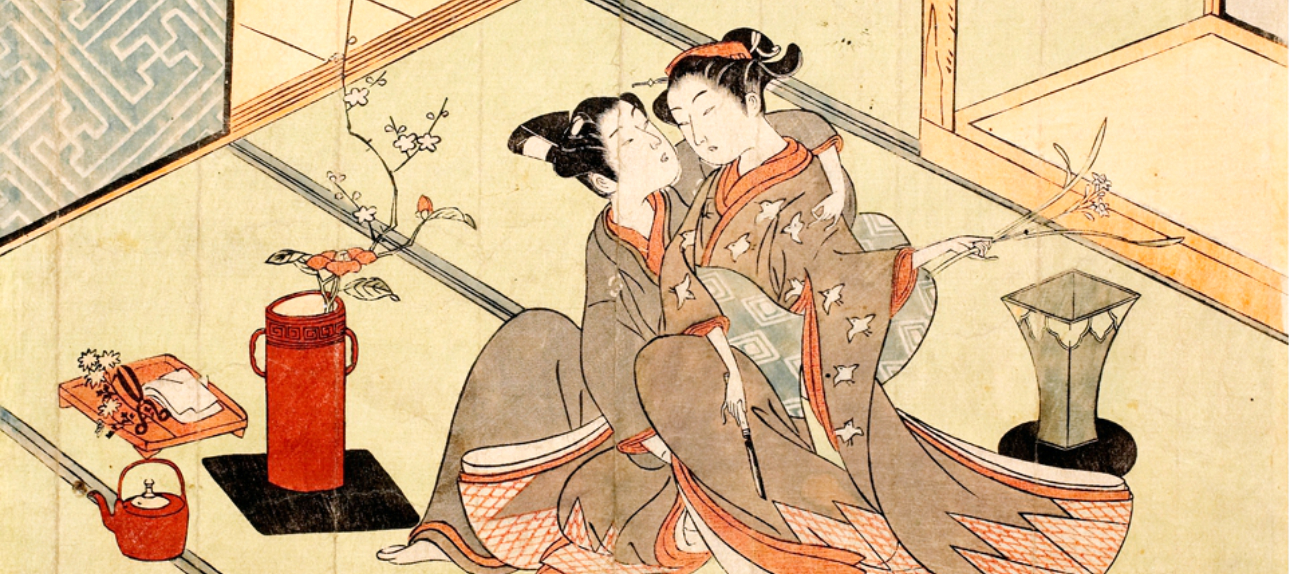For Genji, too much was never enough . . .
When I was in my twenties, I worked at home for several years. I was writing a thesis on Lolita, gazing out at an oak tree in the garden of my cottage, and making endless cups of tea. BBC Radio murmured in the background, the ubiquitous soundtrack of British life. Every morning, the presenter announced the winner of a ‘round tuit’ – listeners nominated someone who was always going to ‘get round to it’ on some household task. It was harmless chatter in between the music which I need when working.
In the years since, I’ve accumulated a formidable list of works I mean to read, when I get round to it. Among these is The Tale of Genji. Nestled in the ziggurat of books beside my bed – between DeLillo’s Zero K and a biography of Mary Wollstonecraft – Murasaki Shikibu’s novel has lain untouched for years. One reason for this delay is the work’s formidable reputation (‘Am I ready for it?’). Another is the commitment it requires; The Tale of Genji is a doorstopper of nearly 400,000 words. It is 1,200 pages long, and weighs over a kilogram. But if not now, when?
While the pandemic rages, I am working at home again, in isolation like everyone else. It is a silvery eucalyptus tree that I see in the garden. Once again, I make countless cups of tea while Spotify plays in the background. The time has come to read The Tale of Genji.
Scholars dispute whether the book is a novel or not – or whether it was the first. Yet it doesn’t need a label to be recognised as a great work of art. The Tale of Genji is a richly-embroidered tale of romance and intrigue at the court of the Emperor of Japan, written around the year 1,000 CE. Apart from literary quality, it is invaluable as a historical document, providing an acutely-observed insight into Japanese life and culture in that period.
What were your ancestors doing a thousand years ago? Mine were sitting in a wattle-and-mud hut somewhere in Britain, coughing as they huddled around a smoky fire, and waiting for someone to invent the chimney. The urbane comforts of Roman Britain were long forgotten. Yet on the far side of the world, a level of civilisation had arisen beyond their imagining. In Japan, this flourished in the Heian (‘peace’) period between the ninth and twelfth centuries: a period recognised as the classical era of Japanese culture, in architecture, music, literature, and art. There was a huge cultural flowering – comparable to that in Elizabethan England.
The Imperial Court was based in Kyoto. Among the courtiers was the woman now known as Murasaki. She was a lady-in-waiting to the Empress, and a renowned poet and novelist in her own lifetime. The Tale of Genji is her greatest work. Most females at this time were married soon after reaching puberty. Murasaki, however, stayed at home with her father well into her twenties. He was a renowned scholar and poet, and she was an eager student. This turned out to be a great advantage when she joined the court, to be a companion for the Empress Shōshi, who had joined the imperial harem at the age of 12. The Empress too, seems to have been an enthusiastic student, and the two became lifelong friends bonded by a love of literature.
Murasaki was not not only a keen observer of life at court, she was finely attuned to the complexities of human relationships. Drawing on her experience, she imagined the most noble man of all: the son of an emperor, charming, handsome, intelligent and cultured, a poet and musician, cunning yet kind-hearted. His name is Genji.
The novel recounts his life at court and many romantic affairs. He falls from favour and is exiled for years. Returning to Kyoto, he marries several wives and takes many consorts (Japan was a polygamous society during this era). Over the years, he does not discard the women he is involved with, but retains them as lifelong friends – adding more and more wings to his palace to accommodate them. Each keeps her household of servants and a private garden designed to her wishes. Sometimes Genji passes an entire day visiting them in this chain of pavilions, chatting, playing music, and reciting poetry. (There are over 800 waka poems in the novel.) At other times, he is skilfully navigating the complex power-play between rival families at court. The tale covers decades, including around 400 characters, and lasts beyond the end of his life. Despite many affairs, Genji’s deepest love is for his life companion, Murasaki (by tradition, the author has been named after her). Once she dies, he is plunged into a fatal grief. His last words to her echo lines of the poet, Henjō, we are told:
Above, below, the dew falls soon and late,
As if to tell us the story of the world.
’Grief does not correspond exactly with love,’ Genji muses. ‘When an old and continuous relationship comes to an end, the sorrow is not just for the relationship itself . . . it is the proliferation of memories . . . that makes for the deepest sorrow.’ The following chapter is entitled, ‘Vanished into the clouds’. It is a blank page. When the story resumes, Genji is referred to in the past tense. Murasaki has described his passing in the most elegant way possible. Genji had every advantage anyone could desire. Yet for him, too much was not enough, as he hungrily sought new experiences. Murasaki’s death teaches him that the quality of experiences is what matters, not their quantity. He wishes that they could have lived a thousand years together, yet knows the final moment of that thousandth year would still come around.
The Tale of Genji paints a shimmering picture of that distant place and time a millennium ago. Genji’s palace of pavilions in Kyoto, gardens alight with lanterns. Mountain-top monasteries above the clouds. The lonely, wind-swept strand of his exile. This world seems exotic, yet also very familiar at times. Murasaki is able to write convincingly from the perspective of both male and female characters. Relationships are immediately recognisable as authentic. When the wife of Yurigi, Genji’s son, has had enough of his behaviour, she storms off to her parents’ house, leaving their young sons behind. ‘So you leave your brats behind for me to look after, do you?’ he asks. ‘Now they’re my brats, are they?’ she replies angrily. The bickering could be from a Family Court transcript of today. Despite the conflict, Murasaki makes it clear that they love each other too, and work – sometimes painfully – towards a new understanding and appreciation of each other.
When Arthur Waley’s translation of Genji was published in the nineteen-twenties, reviewers compared Murasaki to Jane Austen and Marcel Proust. The breadth of her portrait of a society over decades, and her precision in rendering characters, relationships, and how people talk to each other, justify these comparisons. Murasaki moves with absolute mastery between narrative, poetry, characters’ interior monologues, and her own, sometime acid, asides. Like Remembrance of Things Past and other ‘great works,’ being labelled as such can make The Tale of Genji seem daunting and marmoreal. This is a pity. Murasaki’s novel, Like Proust’s, is deeply human, full of humour and sexual adventures, as well as psychological and social insights. Yet the delight she takes in portraying Genji and his society is accompanied by a profound awareness of its ephemeral nature. This is the concept of mono no aware (物の哀れ) – a melancholic sense of the transience of life, seen even today in the Japanese fondness for travelling to watch the cherry trees’ brief blossoming.
We do not know Murasaki’s actual name, but some of her diaries survive, covering the years 1008-1010. Here she imagines how other women at court see her: ‘awkward, difficult to approach, prickly, too fond of her tales, haughty, prone to versifying, disdainful, cantankerous, and scornful’.
I like her already.
—
Murasaki Shibiku. The Tale of Genji. Translated with an introduction by Edward Seidensticker (1976).






thanks for this paul you may be interested to know about a MOOC i’m skating over while in lockdown; its about world literature, run by HarvardX and it covers Goethe , Gilgamesh, Odyssey, 1001 nights, the Lusiads and … Genji!
cheers edwin
Thanks, look forward to some skating :)